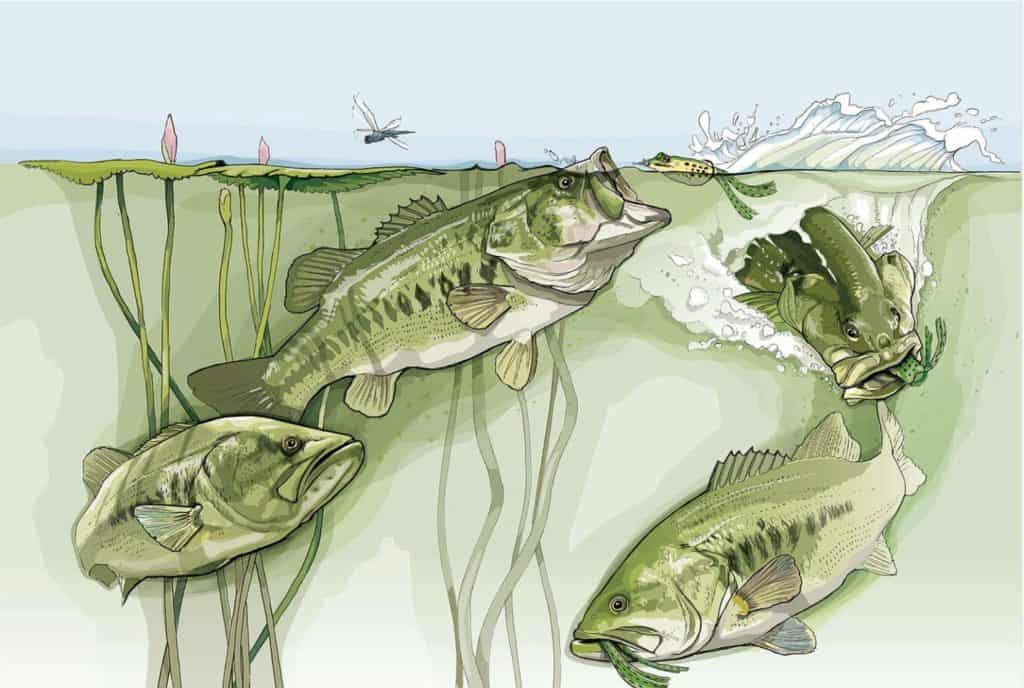Complete Guide On Frog Fishing For Bass
To consistently catch bass on frog baits, you’ve got to understand frog bait styles, tackle selection, and how bass attack their prey. We’ll cover all of that, plus some frog fishing for bass tips.
Sometimes getting bass to hit a frog bait is the easy part. This tactic is notorious for missed strikes. It may seem like you need to match the fish’s speed and power with your hookset, which is partially true, but patience is the real key to more successful swings. You’ve got to understand bass as predators and know exactly how they eat their prey.

Watching a massive bass blow up on a topwater frog bait is one of the most thrilling moments in all of fishing. In a single instant, you get to witness the power, aggression, and speed of our most prominent and willing freshwater predator. The ferocious strike always seems like a miracle, and yet it’s totally inevitable on the best bass water around the country.
4 Steps on Hooking and Landing Bass on a Frog Bait
- The Ambush – Bass are ambush predators and predatory generalists. He’s not hunting for frogs exclusively but waiting for any vulnerable prey to swim by. He detects the vibrations of your frog through his lateral line usually before he ever sees it. The bass may strike in a flash without warning or, if he is especially big, he may flick lily pads with his tail on the way to your bait, a subtle sign of an imminent strike.
- The Grab – He creates suction by dropping his lower jaw and flaring his gills as he attacks. Even if it’s not a direct hit, he’ll likely gulp the bait into his mouth. There are a wide variety of bass strikes (including fully airborne ones), but the most frustrating scenario is when a bass smashes the lure but doesn’t eat it. When this happens, don’t swing. Let the lure sit twitching—like it’s crippled prey. The bass may come back for it.
- The Turn – Bass prefer to eat their prey headfirst, and, if you’re lucky, he’ll gulp the entire frog. Oftentimes, he’ll grab the frog by the head and then shift it around in his mouth while he turns back to cover. Studies have shown that bass can travel about 5 feet in a single second. The average human reaction time is about a quarter second. He’s moving much faster than you are, but if you set the hook now, you’ll still miss him.
- The Hook Set – You must give the bass time to reposition the bait in his mouth so that your hooks have a chance to hit home. This is the hardest part for rookie frog anglers. Wait a full “one Mississippi” after the strike before swinging on the fish. Then keep the pressure on, crank hard, and lift the rod tip high to fight him out of cover. Sometimes you’ll swing and miss, but that just builds anticipation for the next strike.
Frog Bait Colors
One of the biggest misconceptions about frog fishing for bass is that the frog is supposed to represent a frog. Anglers need to keep in mind that more times than not, bass are feeding on bream, shad, and other baitfish, so “matching the hatch” is important. Knowing this, an angler can almost always get away with just 3 colors for any bass fishing water in the country: white, black, and some sort of “bluegill” color.
When to Use a White Frog: This is an obvious choice when bass are keyed in on shad, but I also like white on cloudy, low vis days.
When to Use a Black Frog: This is my go-to for muddy water, as it helps create a more defined silhouette that fish can see easier.
When to Use a Bluegill-Colored Frog: This is an obvious color choice when fish are up shallow feeding on bream, and when fishing around bream beds. But this is also a color to have tied on when the water has good clarity.
Frog Bait Tips
- Boil your frog – Many frogs are rigid when they are new, and this could prevent you from getting a solid hookset. To make the frog “collapse” better, place the plastic body of the frog in boiling water for a few seconds. This will soften the body and help the hook penetrate better.
- Add a rattle – You can find aftermarket rattles in most tackle shops that you can add to give your bait extra noise. This can be a great addition when fishing open water. You simply insert the rattle inside the body of the frog.
- Add tungsten or lead bullet weights – Adding a bullet weight into the body of the frog when you’re fishing extra-thick mats helps the frog “settle” into the mats better so you’re able to effectively work the frog.
- Trim the legs – The original legs on the frogs are usually very long. Long legs create drag in the water and make it very difficult to walk the frog. I like keeping the length, so I vary the trim on the strands to where I am “thinning” the legs without taking away too much length.
Now You Know Frog Fishing For Bass
The possibilities are endless with frog fishing for bass. Once you catch a bass on a frog, you will not want to catch them any other way for a while. Put these tips to use and explore with your own tactics. Good luck out there!

